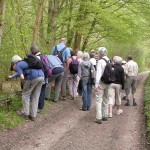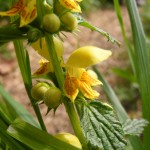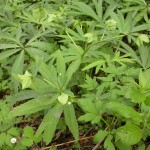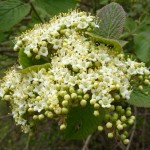The weather was ideal on Sunday 17th April, when Michael Keith-Lucas led a field trip at the Berks, Bucks and Oxon Wildlife Trust’s Warburg Reserve at Bix. As the party left the car park, Michael pointed out nettles amongst the Dog’s-mercury at the side of the track, marking phosphate-enriched soil from horse droppings, from a time when the track had been used by horse-drawn transport. Dog’s-mercury carpeted the thin chalk soils in the woods, but in the valley bottom a bare patch marked an area of acid, well-drained gravel, washed down at the end of the last ice age. The path climbed steeply up through the woods, with flowers including Yellow Archangel, Woodruff and Wood-spurge. Both Common Dog-violets, with their pale notched spurs, and Early Dog-violets, with smaller petals and dark spurs, were identified during the walk. Seeds were developing on the Spurge-laurel plants and a White-pinion Spotted moth posed obligingly on a leaf. The path climbed past enormous, ancient beech stools – an unusual coppice tree.
The group then walked down through an area of Hazel and Hornbeam coppice to an open grassy ride. Clumps of broad-bladed Tor Grass indicated that the ride is not being grazed heavily enough by sheep. Michael explained that ancient chalk grassland is dominated by the plants which sheep avoid, such as poisonous gentians, aromatic thyme and marjoram and fine-leaved Sheep’s Fescue grass. Browsing cattle are much less selective about what they eat. Cowslips were coming into flower along the ride and a Wayfaring-tree was laden with somewhat unpleasant-smelling white flower-heads. The route then led through a steep meadow area. A Hornet was spotted flying into a hole at the base of an ant heap. Closer investigation revealed a hornet’s nest inside the hole. Continuing steeply down through the woods, the thick carpet of Dog’s-mercury beside the path ceased abruptly and was replaced with an area of Wood-sorrel and Enchanter’s-nightshade, indicating a brief transition to more acid soil. A big patch of orange slime, with dripping stalactites of slime, was found on a Sycamore. A debate ensued as to its identity – possibly a slime mould or some form of fungus. (Malcolm Storey subsequently identified it as Fusarium, a genus of fungi often found in fermenting sap.) Ancient woodland indicator species growing at the side of the track back along the valley bottom included Early Dog-violet, Dewberry, Wood Speedwell, Three-nerved Sandwort, Goldlilocks Buttercup and, the botanical highlight of the afternoon, an abundant display of Green Hellebore.
Pictures by Rob Stallard and Jan Haseler
RDNHS excursion to the Warburg Reserve, Bix, Oxon, on Sunday 17th April 2011
led by Michael Keith-Lucas
Plant species observed:
| Alliaria petiolata | Garlic Mustard |
| Allium ursinum | Ramsons |
| Anemone nemorosa | Wood Anemone (leaves) |
| Aquilegia vulgaris | Columbine (leaves) |
| Arum maculatum | Lords-and-Ladies |
| Brachypodium sylvaticum | False Brome |
| Carlina vulgaris | Carline Thistle (last year’s fruits) |
| Carpinus betulus | Hornbeam |
| Circaea lutetiana | Enchanter’s-nightshade (leaves) |
| Cirsium acaule | Stemless Thistle (leaves) |
| Clematis vitalba | Traveller’s-joy (leaves) |
| Cornus sanguinea | Dogwood |
| Dactylorhiza fuchsii | Common Spotted-orchid (leaves) |
| Daphne laureola | Spurge-laurel |
| Euphorbia amygdaloides | Wood Spurge |
| Fagus sylvatica | Beech |
| Festuca ovina | Sheep’s-fescue |
| Fragaria vesca | Wild Strawberry |
| Galium mollugo | Hedge-bedstraw (leaves) |
| Galium odoratum | Woodruff |
| Geranium robertianum | Herb-Robert |
| Glechoma hederacea | Ground Ivy |
| Helleborus viridis | Green Hellebore |
| Hyacinthoides non-scripta | Bluebell |
| Hypericum hirsutum | Hairy St John’s-wort (leaves) |
| Hypericum perforatum | Perforate St John’s-wort (leaves) |
| Ilex aquifolium | Holly |
| Lamium album | White Dead-nettle |
| Lamiastrum galeobdolon | Yellow Archangel |
| Ligustrum vulgare | Wild Privet (leaves) |
| Listera ovata | Twayblade (leaves) |
| Lithospermum officinale | Common Gromwell (leaves) |
| Lysimachia nemorum | Yellow Pimpernel (leaves) |
| Melica uniflora | Wood Melick |
| Mercurialis perennis | Dog’s Mercury |
| Moehringia trinervia | Three-nerved Sandwort |
| Origanum vulgare | Marjoram (leaves) |
| Oxalis acetosella | Wood-sorrel |
| Pastinaca sativa | Wild Parsnip (leaves) |
| Pinus nigra subsp. laricio | Corsican Pine |
| Potentilla reptans | Creeping Cinquefoil (leaves) |
| Potentilla sterilis | Barren Strawberry |
| Primula veris | Cowslip |
| Primula vulgaris | Primrose |
| Ranunculus auricomus | Goldilocks Buttercup |
| Ranunculus ficaria | Lesser Celandine |
| Rubus caesius | Dewberry (leaves) |
| Sanicula europaea | Sanicle (leaves) |
| Scrophularia nodosa | Common Figwort (leaves) |
| Sorbus aria | Whitebeam |
| Stellaria holostea | Greater Stitchwort |
| Tamus communis | Black Bryony (leaves) |
| Urtica dioica | Common Nettle (leaves) |
| Veronica chamaedrys | Germander Speedwell |
| Veronica hederifolia | Ivy-leaved Speedwell |
| Veronica montana | Wood Speedwell (leaves) |
| Viburnum lantana | Wayfaring-tree |
| Viola reichenbachiana | Early Dog-violet |
| Viola riviniana | Common Dog-violet |
Mosses:
Thuidium tamariscinum
Rhytidiadelphus triquetrus
Fungi:
Daldinia concentrica – King Alfred’s Cakes
Piptoporus betulinus – Birch Polypore
Fungus on Mercurialis leaves
Fusarium sp – Orange slime on Sycamore
Insects:
Bombylius major – Bee Fly
Vespa crabro – Hornet
Gonepteryx rhamni – Brimstone
Lomographa bimaculata – White-pinion Spotted
Adela reaumurella (a micro-moth)
Click Beetle (Coleopterae fam. Elateridae)
Birds:
| Fringilla coelebs | Chaffinch |
| Milvus milvus | Red Kite |
| Phasianus colchicus | Pheasant |
| Phylloscopus collybita | Chiffchaff |
| Sitta europaea | Nuthatch |
| Troglodytes troglodytes | Wren |
List compiled by Renee Grayer




